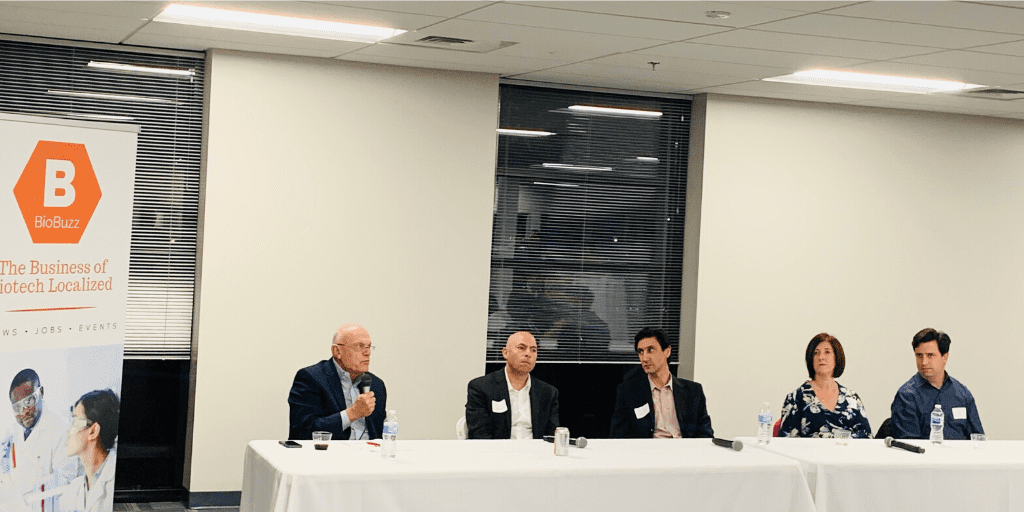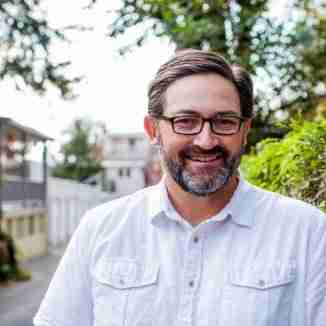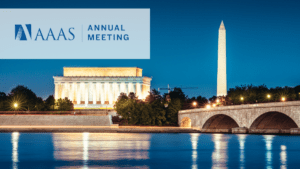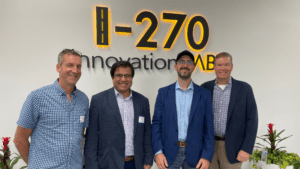
After Leading a Dozen Startups Here is What Four Biotech Founders Had To Share About Their Success
In the heart of Montgomery County, Maryland’s premier biotech district there is a 42,000 SF facility with 17,000 SF vacant lab/office suite located at 9900 Medical Center Drive. The newly delivered and available lab space was designed to foster collaboration and learning with an open layout, a welcoming courtyard and an inside common area that is shared with other local tenants.
Collaboration and learning are exactly what was happening on a Wednesday evening in December as nearly 100 biotech professionals, entrepreneurs and leaders from across the BioHealth Capital Region’s (BHCR) gathered for a ‘CEO Talks’ panel to hear from four CxO’s who are leading the regions most exciting biotech companies.
Hosted by Alexandria Real Estate (ARE) and CBRE, the event was moderated by BioHealth Innovation, Inc. (BHI) Founder, President, and CEO, Rich Bendis. As a renowned innovator, investor and regional ecosystem builder, Bendis has played a part in the success stories for many founders and knows what it takes for a biotech startup to become successful.
The CxO panel featured Greg Merril, CEO of Adaptive Phage Therapeutics; Dr. Murat Kalayoglu, CEO at Cartesian Therapeutics; and the dynamic husband and wife duo, Matt Mulvey, Ph.D. BeneVir CEO at The Janssen Pharmaceutical Companies of Johnson & Johnson and Katherine Sacksteder, Ph.D. and BeneVir COO at The Janssen Pharmaceutical Companies of Johnson & Johnson.
“The event was an excellent opportunity to bring together highly successful life science entrepreneurs to share their insight with others in the industry,” shared Kevin Reap, First Vice President, Life Sciences, CBRE. “ To be able to host the event in one of the few brand new lab spaces available in the heart of the Shady Grove Life Sciences Center was an added bonus.”
This panel wasn’t just any group of founders, they were industry veterans with a track record that many entrepreneurs only dream about. Collectively, the panelists have founded or served as executive officers at 12 companies, raised approximately $100M in funding and have negotiated more than six acquisitions and exits. Bendis led a lively discussion, framing questions around a “lessons learned” theme designed to elicit pearls of wisdom for the engaged audience of fellow BHCR scientists, executives, entrepreneurs, and others.
Here are some highlights from the discussion.
What Inspired Them to Become Entrepreneurs?
The panelists offered a range of responses on what led them to take the risk and the leap to start their own companies.
When asked by Bendis why he became an entrepreneur, Merril, a Montgomery County native, offered with a wry smile, “I was unhirable and had no options so I had to start my own company.” Now of his fourth startup, Merril obviously chose the right path.
His current venture, Adaptive Phage Therapeutics (APT) is a clinical-stage biotechnology company founded to provide an effective therapeutic response to the global rise of multidrug-resistant (MDR) pathogenic bacteria. The company recently announced that it has closed an oversubscribed, non-brokered financing, raising approximately $7M in proceeds. In 2017, APT acquired the world-wide exclusive commercial rights to PhageBank and related technologies from the U.S. Biological Defense Research Directorate of the U.S. Naval Medical Research Center.
Dr. Kalayoglu said he was inspired by his residency program director who left and started his own company: “That was a wake-up call to me that you could actually do something other than academic medicine. At some point I realized that’s not what I wanted; I also didn’t make a very good employee-it was about balancing taking on risk with a fear of failure.” 15 years later, Dr. Kalayoglu is the CEO of Cartesian Therapeutics, a clinical-stage cell and gene therapy company headquartered in Gaithersburg. Prior to Cartesian, Dr. Kalayoglu was co-founder and CEO of Topokine, which he led from concept to late-stage clinical trials, followed by a successful sale to Allergan. He is also a life science investor of note as well.
Sacksteder and Mulvey referenced a variety of factors and events that inspired them to start their own venture, BeneVir, which was acquired by Janssen, a Johnson & Johnson Company, in 2018 for a total potential deal value of $1.04B.
Sacksteder understood early in her career lab work was not for her and her first job allowed her to learn every aspect of a business, preparing her for the rigors of startup life. Mulvey called himself, tongue firmly planted in cheek-“unhirable and stated that he just couldn’t have a boss.
The two met while working together, and Mulvey wanted to commercialize a technology he had invented. And BeneVir was born. “I can only be considered an entrepreneur because of Katie and we did this together, combining forces to get it done,” stated Mulvey.
If You Had One “Do-Over” What Would It Be?
Bendis continued his very insightful line of questioning by asking each panelist about what they might do differently in hindsight.
Merril talked about how sometimes great ideas aren’t enough. Understanding the market is key. He talked about his startup Brain Sentry, which was based on a football helmet that uses sensors to detect the top 2% of the hardest hits to the head. Looking back, Merril said he wished he had listened better to the market, which was a football world that really didn’t want to know this information at the time.
Dr. Kalayoglu wished he had jumped into entrepreneurship much earlier than he did. “The extended experience you get doing it from year one…those years add up. I wish I had a couple of extra years on the front end instead of memorizing the Krebs Cycle that I don’t use anymore,” he shared.
“I don’t think I’d change anything because I’d worry that things wouldn’t have worked out the way they did,” stated Sacksteder.
Mulvey had a different take saying, “I’d change everything.” He went on to tell how he had to take on the role of CEO and CSO and the company suffered because of this. Looking back, Mulvey said he “…would have brought in an experienced CEO who had vast connections to capital that I didn’t have,” he added.
What Was the Greatest Obstacle You’ve Faced?
Bendis moved on to ask the expert panelists about the greatest obstacle they’ve faced and how they managed to overcome it. The responses were diverse and enlightening.
Merril started the discussion by noting that raising capital is always a challenge and that consistently removing risk for investors is critical to securing the financing needed.
“As I was learning the ropes it was always about ‘raising capital’, but now that I’ve matured a bit it’s really about taking risks off of the table. Raising capital always seems to be the problem, but actually the underlying problem is really taking risk off of the table because when you do that the money comes,” stated Merril. He went on to note the different types of risk-technology, execution, and market, to name just a few, emphasizing that market risk is the toughest to assess and then remove for investors.
“The last company I did was a virtual biotech so it was just two of us taking it from concept to registration studies. We outsourced everything and didn’t have to manage folks. We didn’t have to motivate anyone other than ourselves, which wasn’t hard,” stated Dr. Kalayoglu. “This time at Cartesian, I’ve found it challenging to motivate folks that look at careers as a job rather than a mission and you can’t know that until they start working for you…You’d think motivation would be easy since we’re developing curative therapies for incurable diseases. To build a culture driven by the mission is a real challenge and something I try to work on every day,” he added.
“Figuring out how to motivate your employees and finding the right employees are big obstacles. We didn’t really know how to hire people at first and when you’re a small company your first few employees really matter. We got really lucky with our first hire. As we grew, we didn’t always achieve that we had some hits and misses. I’m not sure you can tell from interviews if you’re getting people that are mission-driven,” shared Sacksteder.
Mulvey mentioned that there wasn’t a lot of knowledge about the field when they started and he said they had to figure things out on their own. “It took us a few years to learn everything ourselves and do it ourselves. Learning how to do product development through clinical and how to manage a business was really challenging,” he stated.

How Did You Develop a Strategy to Raise the Capital You Needed to Get Here?
After telling APT’s founding story from its seed round to now, Merril continued to emphasize the importance of de-risking, stating “You’re always are just trying to task risk off the table and as you do this you open up the spectrum of investors that are willing to come in.”
Dr. Kalayoglu emphasized the relationship he and one of his earlier companies, HealthHonors, had established with Schooner Capital 15 years ago. While Schooner Capital didn’t invest initially, this is where the relationship began and trust has built over time. Today, Schooner Capital is a major investor in Cartesian and Dr. Kalayoglu has also done a number of investments with Schooner Capital.
“The amount of capital you need is not always what you read about. If you’re thoughtful with your capital allocation you can do more with less and reach higher valuations and raise the next round at more favorable, less dilutive parameters. That’s our philosophy across our last three companies and it seems to have worked well for our investors,” he stated.
Sacksteder added, “We started out raising capital through small government grants and we had to be extremely judicious with our money.”
“Once we had proof of concept we moved to do a Series A round. We met with a lot of venture capital firms and we got rejected and were told point-blank ‘Oncolytic viruses are stupid.’ We found a group in New York that trusted us…and we did a $12M Series A which helped us hit milestones and build value in the company while derisking the technology,” stated Mulvey. “We had a good plan, good recommendations, and good reputation and it was clear the field was either going to explode or implode and we structured the Series A so they didn’t risk too much money if the field didn’t take off,” he added.
What is the Best Thing That’s Happened to Your Company This past Year (or so)?
Merril recounted a remarkable story of one of APT’s emergency cases. A man who had a knee replacement surgery became infected and had 17 subsequent surgeries. Ultimately, the doctors at the Mayo Clinic decided amputation was necessary; before proceeding, the Mayo Clinic reached out to APT, sending the company a culture of his bacteria; APT matched it to a Phage sent it back, and the Mayo Clinic injected the patient. Within 48 hours there was no sign of infection.
Dr. Kalayoglu recounted another patient’s success story. A 76-year-old woman with relapsed refractory multiple myeloma was close to moving into hospice care. Cartesian developed a CAR T treatment for her escalated her dose and the result was no evidence of a tumor at all with no adverse impacts.
“We designed the product to do just this, to get amazing responses without the toxicity that has become synonymous with CAR T. I’m so proud of my team and all the effort and countless manufacturing runs they did to get it right. It’s very satisfying and I’m quite proud of that,” he stated.
For Sacksteder and Mulvey, getting acquired by Janssen was without question the best thing that happened to their company. Though the actual deal was a bit more than a year ago, the thrill of such a substantial acquisition continues to energize them both.
What Are the Advantages of Building a Business and Operating in the BioHealth Capital Region?
“There are definitely unfair advantages to being here, specifically with the proximity to the NIH and the FDA. That’s a huge advantage,” stated Merril.
“The willingness to enter into these relationships with the ecosystem is easier here than in a place like Boston or San Francisco. We built a state-of-the-art GMP manufacturing facility and piggybacked on to the infrastructure of the 704 Quince Orchard Road building (704QO). Collaborating with ARE and Sheer partners helped us to do this in record time. Partners like ARE and Sheer Partners have been able to help us make a lot of products very quickly, which might not have happened in a more traditional way. This ecosystem is incredibly supportive of life science endeavors,” said Dr. Kalayoglu.
Sacksteder added that she didn’t think she and Mulvey could have started BeneVir in Boston or San Francisco because of the higher cost of living in those biotech clusters. She also noted the Biotechnology Tax Credit offered by the state of Maryland as important to obtaining investment early on.
Mulvey cited strong talent and echoed the importance of cost of living when it comes to launching and growing a startup: “The quality workers you want to recruit are here and they are postdocs in their mid-30s that are establishing a life. You can’t be 35, starting a family and trying to buy a house and work in a high-risk industry like biotech in places like Boston and San Francisco.”
“It’s a great region. Everything is here except for a lot of venture capital offices. What’s great about this area is that it’s growing, there’s more venture capital is coming in, the workforce is diversifying and the ecosystem is diversifying away from just tool companies that only develop assays to real therapeutic and truly diagnostic companies that give the region the mixture it needs,” added Mulvey.
With that, the event moved on to an energetic Q&A session where the audience engaged the panel with a variety of questions ranging from the value of higher-level degrees to the ins and outs of the acquisition process. Afterward, each panelist stuck around for refreshments and networking with attendees, along with guided tours of ARE’s recently renovated facility and new lab space.
During a season marked by giving, everyone left that evening feeling grateful for the gifts of experience and knowledge that these founders so graciously shared. Perhaps years from now someone in the audience will be on stage sharing their stories and how they were inspired to pursue their dream of entrepreneurship after meeting Merril, Kalayoglu, Mulvey, and Sacksteder and hearing their inspiring stories.
- About the Author
- Latest Posts
Steve brings nearly twenty years of experience in marketing and content creation to the WorkForce Genetics team. He loves writing engaging content and working with partners, companies, and individuals to share their unique stories and showcase their work. Steve holds a BA in English from Providence College and an MA in American Literature from Montclair State University. He lives in Frederick, Maryland with his wife, two sons, and the family dog.





